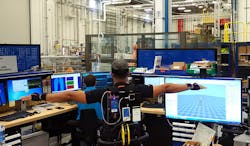Boeing ergonomics engineer Chris Reid was in his 20s, still learning the basics of his discipline, when he realized his father Robert was bringing his work home with him in a very negative way. Working in Palm Beach Country as a landscaper for the parks and recreation department and nights moving boxes for UPS at the airport took their toll and led to issues Robert still deals with today at 63.
“I started to connect the dots from all those years before and recognize that the origins of his chronic pain were due to ergonomic risk factors,” says Reid, who recalls days where his father felt too exhausted and sore to do anything but lay down after work. (As the son of a former steelworker at a pickling plant, I can relate.)
Now every day he is tasked with connecting dots to uncover the cause of workers’ injuries and identifying potential unsafe practices that could affect up to 30,000 to 40,000 Boeing manufacturing workers.
A big part of that is finding a way to prevent work-related musculoskeletal disorders, such as tendinitis, rotator cuff injuries, carpal tunnel syndrome, or severe back strains. The U.S. Bureau of Labor Statistics says these account for one-third of all non-fatal workplace injuries and estimates MSDs require "a median of 11 days away from work to recover." A rotator cuff surgery, which range anywhere from $8,400 to $56,200 could take out a worker for seven months.
So what causes them? OSHA says the following jobs increase the risk of an MSD: “Lifting heavy items, bending, reaching overhead, pushing and pulling heavy loads, working in awkward body postures and performing the same or similar tasks repetitively.” As far as industrial jobs are concerned, they might as well have just said, “work stuff.”
So what is the answer?
For his father, Reid recommended simple fixes widely used and quite obvious on most factory floors: wearing personal protective equipment (PPE) such as work gloves and back braces, adding vibration handles for equipment, using sharpened cutting tools, and switching from rakes to blowers. But it was too late. The retired Reid will forever carry with him the aches and pains, his pension accrued from a lifetime of manual labor.
That personal experience informs the former NASA engineer to change the way leadership attacks this problem.
"What I've been pushing is going toward proactive and predictive ergonomics, where we can foresee what's coming up and try to avoid it," he says. "As a paradigm of safety and how you avoid an incident, you try to engineer it out to begin with."
This usually means throwing a robot at the problem, but certain complex tasks, especially wiring up the overhead of a Boeing 777, is something only a highly skilled human can perform.
"If you can't design or automate it out, that's the niche exoskeletons fill," Reid explains.
Since 2012, Boeing has explored industrial exoskeletons. Portrayed in sci-movies as super powered suits, these wearable tools offer very real solution to the overexertion injury epidemic surreptitiously stealing company productivity and workers' health. Just as stealthily, several startups have gone into full production on these lightweight wearable support devices that cost less than $5,000 and promise to restore what a hard day's work should earn: a decent quality of life.
"It's a disruptor," says Reid, who joined onto the program in 2015. "We don't know where it fits in that safety paradigm, but we know it's in there somewhere."
Boeing is a behemoth of a company, and it has a lot of niches. As of late February, they are still running pilot programs to match the right exoskeleton device to the right job, with the emphasis on extraordinary enhancement for safety and performance.
Oftentimes, exoskeletons also safeguard against the most critical component in your operation going down. In Boeing's case, technicians train for years, even decades, to perform certain operations. If they miss time, they are truly missed.
"When you have to replace them with someone who doesn't have that same experience level, you're going to see potential productivity and quality delays and changes," Reid says.
Still in the experimental phase, Boeing has not deployed them on the factory floor at any of its seven factories.
"So far everything looks very promising," Reid adds.
Reid is also chairing a subcommittee for ASTM International to develop industrywide standards for exoskeletons, leading to a growing number of industry insiders to say these could become full-fledged PPE, and even as consumer devices in the next decade.
So the question now isn't if they will be fully deployed, but how soon?
Pilot Projects Take Flight
Several exoskeleton companies have models ready now, which you can click on the slideshow to see. They range from passive, mechanical upper body rigs that attach like a fall harness and prop up arms in overhead welding or assembly jobs to crazy tele-operated, two-armed tanks that can lift 1,000 lbs. or slice through rebar like its Twizzlers.
Ford investigated the former in May to safeguard workers from MSDs. The cost to companies has been marked at $15 billion directly and may be even higher than $50 billion. That’s not to suggest the UAW-funded pilot project was done for any other reason than to protect its workers. However, lowering MSD-related workman’s comp claims, which account for one out of every $3 dollars to the program, is an added benefit.
The 900-hour trial of Ekso Bionics EksoVest was deemed a success, with 70% of the workers said they would wear it every shift and that it improved performance.
"If you prevent one shoulder injury, you've paid for the device several times over," says Marty Smets, a Ford ergonomics expert says of the $5,000 device.
And once insurers see a company's claims go down, they can expect to see reductions in premiums to further increase that ROI.
But for non-sociopathic employers, worrying about money should be secondary to the safety and well-being of their workers.
"How many lives have to be negatively affected, how much money has to be spent on these injuries, before we realize it's a problem we could have addressed ahead of time instead of being reactive to it?" questions Zach Haas, Ekso's senior product manager.
Haas equates the importance of exoskeletons to that of common personal protective equipment on job sites and factory floors: steel-toe boots, fall harnesses, hard hats, and safety glasses.
"I absolutely see a future where, just like you have to have your fall harness if you go over 4 feet, you aren't allowed to pick up that heavy tool until you put on an exoskeleton."
To get to that point, it will take years of medical testing to prove regulations are needed.
Testing, Testing
Levitate Technologies, which makes the AIRFRAME, has already earned a CE marking as PPE in Europe and has been demonstrated to counteract fatigue and improve productivity in several trials, both internally and by independent researchers.
At BMW, where as many as 66 workers are using them at one time, the AIRFRAME has reduced exertion by up to 40%. This is important because overexertion is akin to stretching a rubber band, and too many instances of that is what can lead to an MSD.
At equipment manufacturer Vermeer, an expert welder wore the AIRFRAME while using Lincoln Electric's VRTEX virtual welder, which digitally tracks and scores speed and accuracy. He doubled his score of 112 welds in 90 minutes from two days prior without the device.
On a painting simulator, workers could spray 27% to 53% more paint before fatigue set in.
"In lean manufacturing, if you squeeze 1% or 2% more out of job, it's a big deal," says Joseph Zawaideh, co-founder of Levitate. "This delivered an 8.2% increase in productivity. And not only did he produce more, he was more comfortable at the end of the day."
Part of the comfort is the reduced number of touch points, which Zawaideh says will keep workers from taking it off in a hot factory during the summer months. And all the medical tests would be for naught if workers won't wear exoskeletons.
"When they first came up with ear plugs and steel toe shoes, they weren't welcomed by workers," he says. "Every new PPE tech that comes out, there is an adoption process. Once they get used to it and understand its value, they think it was wrong to be working without this safety product."
Exo Expansion
Before they reach the consumer space or branch out into Iron Man territory, some agreements must be reached on what exactly constitutes an exoskeleton. For that, ASTM International, which sets voluntary guidelines for manufacturers, has created Committee F48 for Exoskeletons and Exosuits.
At the last meeting February, Reid says 45 of the 90 organizations involved attended.
"What we're starting to figure out, regardless of application, what are the basic things we need to start thinking about," Reid says.
And as talks of what they should be grow, the amount of cross-pollination with other technologies expand as well.
"In the next five years, we'll see crossover between disruptor technologies," Reid says. "You'll start seeing exoskeletons mixing with big data and artificial intelligence, health monitoring and augmented reality."
Every company must come up with their own best way to deploy exoskeletons, if at all. For Boeing, which has the size, applications and money, Reid says they are taking the safest of routes:
"We're going to throw the kitchen sink at it to strategically and tactically tackle these issues."




